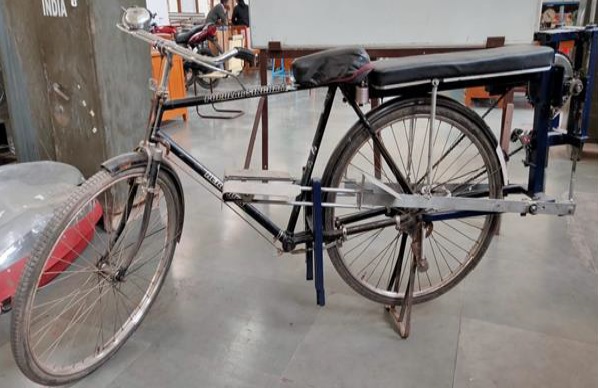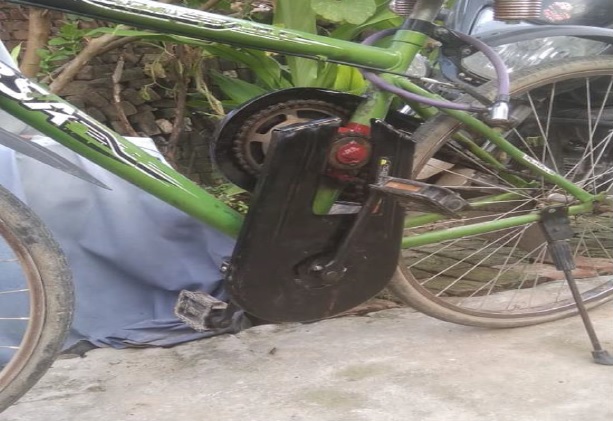Inventor: Mr. Surjeet Singh
Mentor: Dr. Jeewan V.Tirkey
Coordinator: Prof. S.K.Shukla
Description
Principle and feature
The bicycle for human transport comprised of two wheels and require balancing by the rider invented in early 19th century. The use of a rotating wheel in bicycles and other wheeled vehicles not only saves energy of human being instead of walking, but also saves the time to reach destination. In the present bicycle, the speed of the cycle is moderate, which depends on teeth ratio of crank arm sprocket and free wheel sprocket. The movement of foot lag in bicycle at crank arm pedal is limited, which restricts the bicycle run in higher speed. The modern cycle approached to increases the speed by using multi sprocket mechanism at crank arm and at free wheel attachment. The higher sprocket teeth ratio increases the speed of bicycle and vice versa, thus changing of speed are obtained. As per the market survey, the cycle is mounted with medium range sprocket ratio of 2.75 corresponding to 44 teeth of paddle arm sprocket and 16 teeth of freewheel sprocket, however, the maximum ratios were found as per sprocket availability in market 3 to 4. Thus, for the more speed, beyond of this sprocket ratio, an additional mechanism will be required.
Therefore, the objects of this invention are to provide improved means for varying the bicycle speed with same revolution of crank arm paddle as conventional. The aim of our invention is to obtained higher sprocket ratio than the present value, i.e. more than 4. To do this, bicycle sprocket was linked with an auxiliary sprocket wheel assembly having two number sprockets, in which the one sprocket is bigger and another is smaller equals to freewheel sprocket assembly attached to a common axle. The auxiliary axel with two sprocket wheel assembly together placed at down tube of cycle frame and finally chained to the freewheel of rear wheel sprocket, which enables very high speeds to be attained by the average rider. The overall sprocket ration was obtained 5.8 sprocket ratio with the combination of four sprocket teeth of 44 ,18, 44, 18. There is chain tighten device is also included to solve the issues of chain slagging during movement.
Drawings and Embodiment
The final bicycle was constructed by attempting number of trial version. The first one was attempted in order to provide reciprocating motion of lag in place of rotary motion of paddle. In this work, the lever operated wheel transmission was adopted so that man power could be reduced at paddle and sprocket mechanism was introduced to increase speed. Rider pushes the paddle down ward alternatively and bicycle moves forward. The man power was reduced, easy to paddle push, speed increased, but, due to lack of rider acquainting, it became non convenient to ride. The layout of detailed construction and final shape of bicycle are shown in figure C-1 and figure C-2. Concerning these aspects, another mechanism was processed, which was related to linking of axillary axel, integrated with small and big size sprocket, placing at down tube of cycle frame below seat. In this system, paddle sprocket rotates by man power, drives axillary smaller sprocket, smaller and bigger sprocket rotates in same speed as it is in common axle, bigger sprocket drives smaller sprocket of freewheel through chain, and thus rear wheel moves with increased speed. The photograph of final actual bicycle is shown in figure C-3.

Figure C-1, Layout of reciprocating paddle operated bicycle

Figure C-2, Photograph of final Lever based paddle operated bicycle

Figure C-3, Photograph of axillary axle-based compound train sprocket bicycle
Accessories and Bill of Material
The man powered bicycle has been fabricated in view of high speed and comfortable for rider. There were many items, material was used during the trial alteration and modification, some of the material wasted and some used to be finalized. The final outcome of bicycle comprises the following particulars.
| S. N. | Particular | Quantity |
|---|---|---|
| lever-based bicycle | ||
| 1. | Pedal plate rod (7 feet) | 2 |
| 2. | Hing rod with 7-inch straight gear | 2 |
| 3. | Back rest seat | 1 |
| 4. | Frame (heavy pipe rod for assembling other parts) | 1 |
| 5. | Rotating gears male female both | 2 |
| 6. | Hub rod for assembling gears | 1 |
| 7. | Spring for supporting pedal | 2 |
| 8. | Supporting pedal section arrangements | 2 |
| 9. | Gear of 48 teeth with back system | 1 |
| 10. | Chain | 1 |
| 11. | Free wheel | 1 |
| 12. | Fasters and miscellaneous | |
| axillary axle-based compound train sprocket bicycle | ||
| 1. | Hybrid cycle for fast running | 1 |
| 2. | Big sprocket (42 teeth) | 1 |
| 3. | Free wheel | 1 |
| 4. | Chain | 1 |
| 5. | Chain guard cover | 2 |
| 6. | Hub system for centre arrangement | 1 |
| 7. | Chain tightening set | 1 |
Advantages and Disadvantages
There were many mechanisms were attempted to obtain simplification in fabrication and to maintain comfortable for rider. Inventor fabricated two types of bicycle for high speed run. First is lever based driven, second is axillary axle-based compound train sprocket mechanism.
The lever based driven bicycle possesses following advantage and disadvantages.
Advantage-
Disadvantage-
The axillary axle-based compound train sprocket mechanism bicycle possesses following advantage and disadvantages.
Advantage-
Disadvantage-
Testing
During testing of lever-based bicycle, it was found that it is easy to drive in terms of lower man power consumption, and speed increased. However, it is not convenient to drive some time due to lack of acquainting. Similarly, during testing of axillary axle-based compound train sprocket mechanism bicycle, it was found that bicycle speeds up after overcoming the pickup range. It runs almost double speed than the conventional bicycle. At the initial stage during pick up, slightly higher man effort is required. Besides, there is no problem for parking and handling to this bicycle.
© 2019.CST UP Incubation Centre for Grass root Innovators. All Rights Reserved.
Design & Developed By TND Soft Technologies